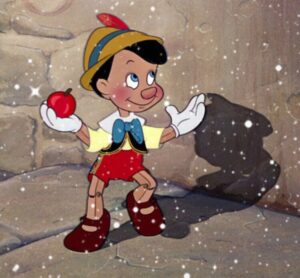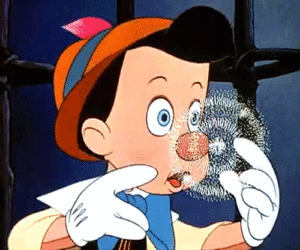Cartoon Character ( Pinocchio) Whose Nose Grows

The cartoon character whose nose grows when he tells a lie is Pinocchio. Pinocchio is a classic character created by Italian author Carlo Collodi in his novel “The Adventures of Pinocchio,” and the character has been adapted into various animated films and television shows over the years. In the story, Pinocchio is a wooden puppet brought to life by a fairy, and his nose grows longer each time he tells a lie, making it a prominent and iconic feature of the character.
“Pinocchio” is a classic children’s story that originated in Italy and was written by Carlo Collodi. The full title of the original novel is “The Adventures of Pinocchio” (in Italian, “Le avventure di Pinocchio”). It was first published as a serial in an Italian newspaper from 1881 to 1883 and later compiled into a novel.
The story follows the adventures of Pinocchio, a wooden puppet carved by the old woodcarver Geppetto. Pinocchio longs to become a real boy and is brought to life by the Blue Fairy. However, he is not initially a well-behaved child. He often tells lies and gets into trouble, which is when his nose starts growing longer and longer.
The growing nose serves as a visual indicator of Pinocchio’s dishonesty and is a central element of the story. It teaches children about the consequences of lying and the importance of honesty.
Throughout the story, Pinocchio encounters various colorful characters, including the cunning Fox and Cat, the kindly Cricket, the puppeteer Mangiafuoco, and the talking cricket, who serves as his conscience. He also faces numerous trials and tribulations on his journey to becoming a real boy.
Ultimately, Pinocchio’s character development is a key theme in the story. As he learns from his mistakes and strives to be a better person, his nose stops growing, and he becomes a real boy as a reward for his transformation and good behavior.
“Pinocchio” has been adapted into numerous stage productions, films, and other media over the years, including the famous 1940 Disney animated film “Pinocchio.” The character’s iconic growing nose and the moral lessons about honesty and personal growth have made Pinocchio a beloved and enduring figure in children’s literature and animation.
Here are some more details and insights into the character of Pinocchio and the enduring legacy of the story:



- Character Traits: Pinocchio, at the start of the story, is depicted as mischievous, disobedient, and easily influenced. He often makes impulsive decisions and tells lies, which result in his nose growing longer. As the story progresses, he learns important life lessons and gradually transforms into a more responsible and honest individual.
- Geppetto: Geppetto is the elderly woodcarver who creates Pinocchio and serves as his father figure. His deep love and concern for Pinocchio drive much of the story’s emotional weight. Geppetto’s kind and caring nature highlight the importance of parental guidance and the bond between parents and their children.
- Blue Fairy: The Blue Fairy is a magical character who brings Pinocchio to life and watches over him throughout his adventures. She represents hope, redemption, and the potential for personal growth. The Blue Fairy is also a symbol of goodness and guidance in Pinocchio’s life.
- Moral Lessons: “Pinocchio” is renowned for its moral lessons, teaching children about the consequences of lying, disobedience, and making poor choices. It emphasizes the values of honesty, responsibility, and the importance of listening to one’s conscience.
- Adaptations: Besides Disney’s famous 1940 animated film, “Pinocchio” has been adapted into various movies, television shows, stage plays, and books over the years. These adaptations often reinterpret the story while maintaining its core themes of transformation and morality.
Literary Significance: Carlo Collodi’s novel “The Adventures of Pinocchio” is considered a classic of children’s literature. It has been translated into numerous languages and has captivated generations of readers with its timeless storytelling and memorable characters.
- Cultural Impact: The character of Pinocchio has become an enduring symbol of childhood and imagination. His nose-growing gag is instantly recognizable and has become a pop culture reference. The story’s themes continue to resonate with both children and adults.
- Educational Tool: “Pinocchio” is often used as an educational tool to teach children about the importance of honesty and the consequences of their actions. Teachers and parents have used the story as a way to engage young readers in discussions about morality.
Pinocchio is a beloved character in children’s literature whose story has left a lasting impact on popular culture and continues to be cherished for its valuable life lessons and timeless appeal.
let’s delve deeper into various aspects of Pinocchio and its enduring significance:
1.Origins and Authorship:
- Carlo Collodi, whose real name was Carlo Lorenzini, wrote “The Adventures of Pinocchio.” The story was originally serialized in an Italian newspaper called “Giornale per i Bambini” (Children’s Newspaper) from 1881 to 1883 before being published as a book.
- Collodi’s work was initially intended as a serialized story for children but evolved into a more complex narrative with moral lessons as it progressed.
2. International Impact:
- It has been translated into numerous languages, making it one of the most widely read and adapted children’s stories in the world.
- It has inspired adaptations in various cultures, with different interpretations and variations of the story.
3. Disney’s Animated Adaptation:
- Disney’s 1940 animated film, is one of the most iconic adaptations of the story. It is known for its groundbreaking animation and memorable songs like “When You Wish Upon a Star.”
- The film’s success helped solidify Pinocchio’s status as a beloved character in the Disney pantheon.
4. Symbolism and Themes:
- It’s often analyzed for its rich symbolism. For example, Pinocchio’s transformation from a wooden puppet to a real boy is seen as a metaphor for personal growth and development.
- The Blue Fairy, who guides Pinocchio, represents the idea of redemption and the potential for positive change.
5. Influence on Pop Culture:
- The character of Pinocchio has appeared in various forms in literature, theater, film, and even advertising. His instantly recognizable long nose and whimsical appearance make him a versatile symbol.
6. Educational and Moral Lessons:
- The story of Pinocchio continues to be used as an educational tool to teach children about honesty, the consequences of lying, and the importance of making responsible choices.
- Pinocchio’s journey from a mischievous puppet to a real boy serves as a powerful parable for personal growth and moral development.
7. Legacy:
- It remains an enduring character who is often referenced in popular culture, from cartoons to literature to merchandise.
- The story’s universal themes continue to resonate with audiences of all ages, making it a timeless classic.
8. Adaptations and Spin-offs:
- Beyond Disney’s adaptation, there have been numerous reinterpretations of the Pinocchio story, including live-action films, stage productions, and modern retellings.
- Some adaptations have explored darker and more mature aspects of the story, emphasizing its allegorical nature.
9. Psychological Interpretations:
- “Pinocchio” has also been examined from a psychological perspective. Some interpretations suggest that the story can be seen as an allegory for the human journey towards self-awareness and moral development.
- The character of Pinocchio’s nose growing when he tells a lie can be seen as a representation of the physical and emotional consequences of dishonesty.
10. Illustrations and Visual Adaptations:
- The character of Pinocchio has been brought to life through various artistic interpretations and illustrations. Different artists and animators have put their unique spin on the character’s appearance, contributing to the visual diversity of the story.
11. Morality and Consequences:
- “Pinocchio” teaches children about the importance of taking responsibility for one’s actions. Pinocchio faces various consequences for his misdeeds, emphasizing the idea that actions have repercussions.
- The story encourages readers to listen to their conscience, represented by the talking Cricket, as a guide to making ethical decisions.
12. Influential Characters:
- Besides Pinocchio, other characters in the story have also left their mark on popular culture. Characters like the cunning Fox and Cat, the wise Blue Fairy, and even the malevolent puppet-master Stromboli have become memorable in their own right.
13. Cultural Adaptations:
- “Pinocchio” has been adapted into different cultural contexts and settings, showcasing its adaptability as a universal story.
- These adaptations often incorporate cultural elements and themes unique to their regions while retaining the core narrative of personal growth and morality.
14. Literary Legacy:
- The success of “Pinocchio” has influenced subsequent children’s literature, inspiring other authors to create stories with strong moral and educational elements.
15. Contemporary Relevance:
- “Pinocchio” remains relevant in the modern age, as its timeless themes of honesty, personal growth, and the pursuit of becoming a better person continue to resonate with readers and viewers.
16. Teaching Tool:
- Teachers and educators often use “Pinocchio” in classrooms to discuss not only moral and ethical topics but also literary concepts such as character development and symbolism.
17. Theme Parks and Attractions:
- Disney theme parks around the world feature attractions and experiences based on the character of Pinocchio and his adventures. This has further solidified the character’s place in popular culture.
18. Critical Analysis:
- Scholars and critics have written extensively about “Pinocchio,” exploring its deeper themes, historical context, and its significance in the realm of children’s literature and storytelling.
It’s a literary masterpiece that has transcended generations and cultures, offering valuable moral lessons and captivating storytelling. Its enduring popularity and adaptability demonstrate its lasting importance in the world of children’s literature and entertainment.
